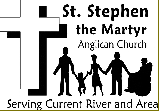Reading a Lesson
Voice
Your voice helps people to worship. Read the scripture so that they hear it and understand what you are saying, you are giving voice to God’s Word.
Work at speaking loudly without shouting, and clearly without mumbling. Don’t forget to breathe; it is like singing, without air, you don’t have much volume. How fast you speak is important: it should not be so fast that it is rushed, nor should it be too slow.
Diction is important. Work on saying the consonants in the middle and end of words. Diction helps you to speak clearly. For people with hearing difficulty, good diction and a moderate pace are important; otherwise, people will hear your words slurred together.
Once you have the basics down, try adding some inflection and to add emphasis to the reading. The tone should fit the context of the reading; joyful where it is joyful, sad where it is sad.
Preparation
Read the lesson out loud ahead of time from the translation you will use during worship. The lectern Bible at St. Stephen’s is the New Revised Standard Version (NRSV). Several NRSV Bibles are in the pews and Vestry Room for your use.
The Bible is a library of books. The three sections are Old Testament, or the Hebrew scriptures, the Apocrypha or books between the Old and New Testaments, and the New Testament, which has the Christian writings. To find a particular book, look it up in the index, or commit the order of the books to memory.
A reading is written in a particular format, for example, Ezekiel 37:1-14, thirty-seven is the chapter, and the numbers after the colon (:) indicate the first and last verses of the passage. For a passage that includes several portions from different chapters such as Genesis 2:15-17; 3:1-7, the semi-colon (;) separates the portions. Sometime a reading will be given showing a partial verse such as Romans 6:1b –8. A verse may have two or three sentences in it and the reading may start at “b” the second sentence or “c” the third sentence or ending with “a” the first sentence as in Isaiah 4:5-9a.
If the passage begins with a pronoun, insert the proper name, ex. “After they proclaimed the good news” (Acts 14:21) read, “After Paul and Barnabas proclaimed the good news.” Read the scripture just before where the passage starts to determine who is speaking.
Check out the passage for words that are difficult to pronounce. Hard words in the Bible may be printed phonetically, ex. Zech-a-ri’-ah. A small book, ‘A Guide to Pronouncing Biblical Names’ that gives phonetic pronunciation of words, is kept with the lectern Bible for readers to reference. A tip, syllables normally begin with a consonant. Ask the clergy or an experienced reader for assistance.
Preparation at the Church
Look at the lesson in the lectern Bible prior to the service and notice where the passage starts and stops. This helps you find your place when you go up to read.
Ensure the marker is in the right place.
Lectern Light and Mike
If the light is not on, turn it on so that you can see. Position the mike so that it points directly at your mouth, no closer that 2 inches or 5 centimeters.
Even if you have a good voice, use the mike. People who are deaf, are deaf in different frequency ranges, and they may be deaf in the range your voice is in.
Reading a Lesson
Walk up to the Bible as soon as it is appropriate. You may want to ensure that you sit near the aisle.
Look at the congregation before you begin. Introduce the reading with, “A reading from [name of book]”. You don’t need to say, “The reading is taken from …” nor do you need to give the chapter and verse. The chapter and verse is in the bulletin so, that if people want to, they may read along in a pew Bible or look it up at home later on.
Read the lesson with conviction.
When finished look at the congregation and say, “The Word of the Lord”. People should respond with, “Thanks be to God.” Turn the page in the lectern Bible to the next lesson so it is ready for the next reader.
It is appropriate to look at the congregation when you start the reading and once you have finished. To look while you are reading may cause you to loose your place.
When you pass the altar, it is customary to bow at the cross.
Giving the Context for the Lesson
The context can include when, where and what has just happened or just been said. It is given after the reading has been introduced.
Readers do not have to give the context, but if you can, it is helpful to people in the congregation. People coming to worship with little knowledge of the Bible may not know the context of a passage of scripture without assistance.
To figure out the context, read the scripture just before and just after the passage that you are reading; look at the paragraph headings; look at the written introduction to the book of the Bible and/or read about the Book the passage is from in Eerdman’s Dictionary of the Bible found in the library in the Parish Hall. An example of an introduction for a reading from Philippians, ‘Paul is writing from prison to the church in Philippi’; or from Exodus, ‘Moses is speaking to the people after they have worshiped the golden calf while Moses was on Mount Sinai’. As you prepare your introduction, imagine someone hearing your reading with no knowledge of the Bible.
For a discussion of the lectionary and how the reading is used in planning the worship, see:


